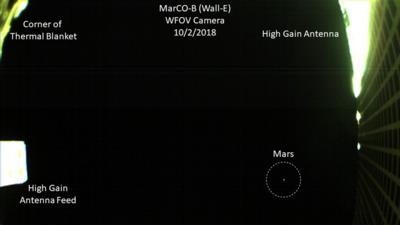Sun, Oct 28, 2018
MarCO Mission Designed To Prove A Concept
NASA's MarCO mission was designed to find out if briefcase-sized spacecraft called CubeSats could survive the journey to deep space. Now, MarCO - which stands for Mars Cube One - has Mars in sight.

One of the twin MarCO CubeSats snapped this image of Mars on Oct. 3 - the first image of the Red Planet ever produced by this class of tiny, low-cost spacecraft. The two CubeSats are officially called MarCO-A and MarCO-B but nicknamed "EVE" and "Wall-E" by their engineering team.
A wide-angle camera on top of MarCO-B produced the image as a test of exposure settings. The MarCO mission, led by NASA's Jet Propulsion Laboratory in Pasadena, California, hopes to produce more images as the CubeSats approach Mars ahead of Nov. 26. That's when they'll demonstrate their communications capabilities while NASA's InSight spacecraft attempts to land on the Red Planet. The InSight mission won't rely on them, however; NASA's Mars orbiters will be relaying the spacecraft's data back to Earth.)
This image was taken from a distance of roughly 8 million miles from Mars. The MarCOs are "chasing" Mars, which is a moving target as it orbits the Sun. In order to be in place for InSight's landing, the CubeSats have to travel roughly 53 million miles. They have already traveled 248 million miles.
MarCO-B's wide-angle camera looks straight out from the deck of the CubeSat. Parts related to the spacecraft's high-gain antenna are visible on either side of the image. Mars appears as a small red dot at the right of the image.
To take the image, the MarCO team had to program the CubeSat to rotate in space so that the deck of its boxy "body" was pointing at Mars. After several test images, they were excited to see that clear, red pinprick.
"We've been waiting six months to get to Mars," said Cody Colley, MarCO's mission manager at JPL. "The cruise phase of the mission is always difficult, so you take all the small wins when they come. Finally seeing the planet is definitely a big win for the team."
(Image provided by NASA)
More News
DETRESFA (Distress Phrase) The code word used to designate an emergency phase wherein there is reasonable certainty that an aircraft and its occupants are threatened by grave and i>[...]
"General aviation is at the forefront of developing and introducing innovative technologies that will transform the entire aviation industry..." Source: Kyle Martin, Vice President>[...]
Direct Straight line flight between two navigational aids, fixes, points, or any combination thereof. When used by pilots in describing off-airway routes, points defining direct ro>[...]
Aero Linx: Women in Corporate Aviation Women in Corporate Aviation support individuals seeking career advancement and professional development in the business aviation industry. Me>[...]
“We would like to thank the many volunteers that help throughout the year to pull off the event, as well as the several reviewers, judges, and SURVICE staff that provide team>[...]
 ANN's Daily Aero-Term (04.26.24): DETRESFA (Distress Phrase)
ANN's Daily Aero-Term (04.26.24): DETRESFA (Distress Phrase) Aero-News: Quote of the Day (04.26.24)
Aero-News: Quote of the Day (04.26.24) ANN's Daily Aero-Term (04.27.24): Direct
ANN's Daily Aero-Term (04.27.24): Direct ANN's Daily Aero-Linx (04.27.24)
ANN's Daily Aero-Linx (04.27.24) Aero-News: Quote of the Day (04.27.24)
Aero-News: Quote of the Day (04.27.24)



